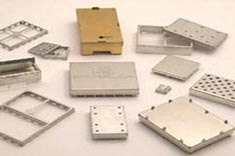EMI Shielding Products
- Custom Gasket Fabrication
- Connector Gaskets
- Bonded O Ring
- Custom Gaskets
- Conduct-O-Knit Knitted Wire Mesh
- Conduct-O-Seal Combo Gasket
- Conduct-O-Elastomer
- Conduct-O-Seal Oriented Wire in Silicone Gasket Material
- Conduct-O-Mesh Tape
- Conduct-O-Foam
- Conduct-O-Bond
- Optical Filters For Electronic Displays
- Shielded Vent Panels
- ESC Board Level Shielding
- 300 Series
Why Does Plastic Electronics Need EMI Shielding?
It would be hard for an individual to go through a typical day without interacting with one or more electronic devices. These devices emit electromagnetic interference (EMI) and radio frequency interference (RFI), which causes concern for manufacturers and users of electronic goods. All electronics emit magnetic and electrical energy, and when that energy interacts with a neighboring device, it will cause both devices to malfunction. Most frequently, EMI is created with frequencies between 1 Kilohertz and 10 Gigahertz (range known as RFI band). The most common sources of interference are:
- Radar transmitters
- Lighting
- Radios
- Smartphones
- Motors
- Appliances
- Television
- Microprocessors
- Computers
- Measuring instruments
- Navigation systems
- Broadcasting receivers
Many manufacturers have been turning to plastic for its price and characteristics. As a result of more plastic being used for electronic devices, EMI and RFI shielding have become essential for constructing devices. Plastic is considered an insulator so that electromagnetism can pass freely through them.
To protect plastic electronic devices, the shield must be applied to block waves. Plastic housings are coated with a conductive layer, which adds necessary shielding. The coating method is simple and not completely dependent on the quality of housing. To fully gauge the effectiveness of a project, sets of specific tests and measurements must be accomplished.
If you build electronic devices with plastic parts or housings, do not neglect the device’s need for protection from EMI and RFI. We provide top-quality RFI shielding and EMI shielding.
Related Reading for EMI Shielding
- Understanding Gasket Junction Design
- Effectiveness of EMI Shielding
- Understanding Different EMI Shielding Effectiveness Tests
- Three Methods for Producing EMI Shielding GasketsWe are your one-stop shop for EMI gaskets and EMI shields. Reach out to us today for more information about protecting your election applications.



